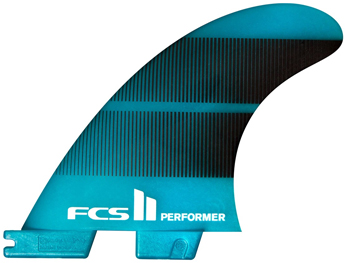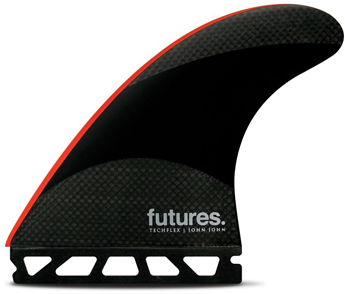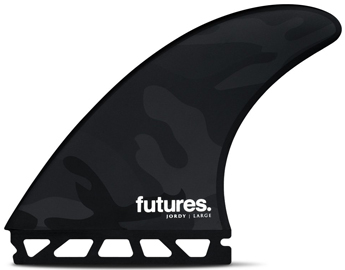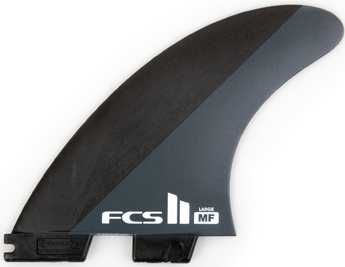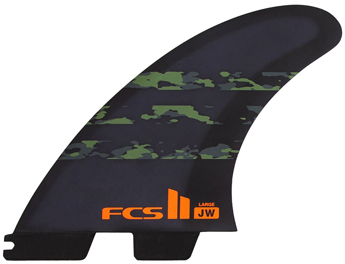Best Surfboard Fins
Performance surfboard fins are probably the most difficult piece of equipment for most surfers to choose.
Whether your board is fitted with FCS II or Futures boxes, the variations setups, surfboard fin templates, flex pattern etc. make selecting the right fin design to maximize your surfing performance a bit of a minefield.
But there's no need to despair. Rather than diving into hours of study about the relative effects of rake, cant, foil and toe-in, let me help you out with my guide to 5 of the very best thruster fins currently on the market.
Quick Glance:
#1 Best for versatility - FCS Performer →
#2 Best for powerful waves - Futures John John →
#3 Best for small waves - Futures Jordy →
More...
Contents
The 5 Best Surfboard Fins
The FCS II Performer series thruster fins are the company's entry into the "Balanced" performance fin category. Designe
d to go well in a wide range of wave conditions, with a mix of speed, control and responsiveness, they're made using the FCS Performance Core (PC) construction, which keeps them nice and stiff near the base with more flex gradually coming in toward the tips.
I bought a DHD SweetSpot 2.0 in Bali a while ago which came with a free set of these.
They work really well and definitely live up to their aim of giving a balanced ride.
If you're only going to have one tri fin set and want them to perform in a wide range of wave types from beach breaks to reef, regardless of the aim of your surf session, you can't go far wrong with these.
Equally, being a well balanced fin setup, I like to use these as a point of comparison against other sets I'm trying out. It's good to have a solid benchmark so you can feel whether changes you make are taking you in the right direction or not.
Pros and Cons
John John Florence is one of the best surfers in the world, ever.
He is equally comfortable throwing buckets of spray, launching big air rotations, or driving from deep undercover at pipeline.
So the question is, will using JJF's fins make you surf like him?
Well, no. I've been using these regularly for the last couple of years and I still surf like a human.
I can't blame the board either; I often use these on my Pyzel Phantom (an upsized version of John John's own Ghost model).
The good news is they do let me surf like the best version of myself.
Part of the "Speed Control" series (Ride number 3.4), these fins give me the confidence to push myself when the waves are really on. They hold through turns perfectly, lending stability and hold exactly when needed the most.
The Futures system of one piece fin boxes is also my favorite. I find them stronger and easier to fit than FCS II (I once accidentally punched myself in the face trying to remove a stiff FCS II center fin, which was rather embarrassing)
On smaller summer days I'll switch to something with a bit more drive, but these are likely to remain my go to fin set whenever it pumps.
Pros and Cons
South African legend Jordy Smith uses his signature fins in a wide range of surf conditions, although he tends to switch to a set of Al Merricks when the waves get really big.
This Futures tri fin setup has quite similar characteristics to the MF FCS II set I've included in this review.
Designed primarily for drive and control to match the power of Jordy's style, these have a high rake angle and side fins slightly larger than the center fin.
A Honeycomb construction gives strength and controls the flex while keeping the weight down.
I usually use these on the same shortboard as the JJF set, but for different waves. With a Ride Number of 5.5 (squarely in the Balanced category) I find the extra drive really helpful when the waves aren't giving as much power.
Pros and Cons
I'm going to try and remain objective here, and I'm going to fail.
The MF signature fin set are my favorite FCS fins of all time, inspired by my favorite surfer of all time, so I'll just admit my bias straight away and be done with it.
These fins are designed for power surfing. Shaped for drive and hold through big turns on open faced waves, they really helped me draw out lines and work on surfing smoother and faster.
Given my penchant for point breaks especially, I can't really say enough about how much fun these have given me. (although maybe the attached image showing how faded and worn my set have got from constant use will give you some idea).
However, if you're looking to loosen up your ride, these are probably not for you. They're fairly stiff and tall with plenty of rake, very much designed to control the power generated by both the wave and the surfer. If you want to get some sideways movement in the tail, you're pretty much going to have to get the fins free rather than a classic tail slide.
Pros and Cons
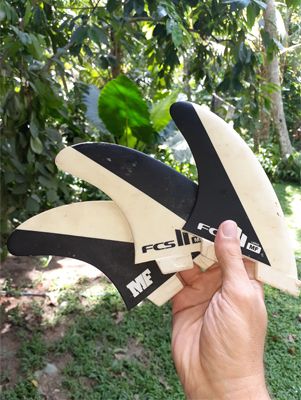
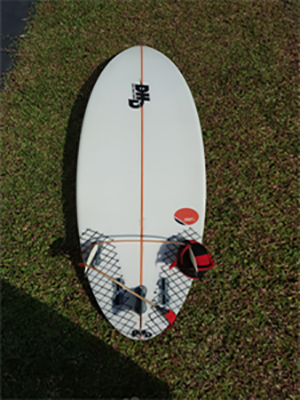
The Julian Wilson signature fin templates are designed with more of an eye to aerial surfing than the Fannings, although they still have plenty of control on the face and are also considered part of the Carver series.
JW is one of the more progressive surfers on tour so he needs the balance and versatility to perform all sorts of different maneuvers on the same wave.
This is well reflected in the balanced characteristics of his fins.
These fins are made using a similar Performance Core construction as the FCS II Performer but with an added AirCore which reduces weight.
They're fast and responsive, which can be a tricky combination to achieve.
I'm not much of an "above the lip" guy myself but I know a few surfers who love to push themselves in that direction and I've heard nothing but good things about these fins. The word is the combination of speed and control allows surfers to get really good projection out of the lip and land back into the sweet spot (or even out into the flats).
The only criticism I'd have of these is they generate enough speed that on a slow-peeling wave it's almost difficult to stay in the pocket unless you can get up and down really quickly.
Pros and Cons
FAQ
How many fins should a beginner surfer have?
For stability and control when learning to surf, a thruster (tri fin) set is the most common choice for beginners. Although it makes little difference in those first few whitewater waves, Twin fins do not hold the line as well when people start getting out onto the open face, while quads can be trickier to turn efficiently.
Do surfboard fins really matter?
The more advanced a surfer is, the more difference they will feel when changing fin template or arrangement. Beginners taking off in the whitewater will not really be aware of the effect their choice of fins is having, whereas for experienced surfers the whole style of surfing they can do will change drastically when changing between a twin fin, thruster or quad set.
Which is better, FCS II or Futures fins?
The two systems are both very good. The main difference is in how you change out the fins. The FCS II fins pop in and out by hand, whereas the Futures fin box uses a fin screw to hold them in. Futures are the strongest system overall so if you don't swap your fins often I'd recommend them. However, if you like being able to make quick changes without needing a fin key, FCS II might be for you.
How To Choose The Right Fins For Your Surfboard
The first thing to consider is getting the correct fin size for you. Each model has a size chart telling you the recommended weight range for the various versions (which normally run from Grom up to Large). There is also a board length aspect however, so if you are looking for a new fin setup for your longer, step-up surfboard, consider getting a size larger than your regular shortboard.
The surfboard design itself has a significant effect on the best fin setup to pair it with. A board which is fast and loose, for example, will be well complimented by a fin set with a bit of extra surface area to add control at speed.
Other than that, you can choose what to put in your cart primarily on the fin characteristics themselves. Think about the surf conditions you want to use them in (wave height and power, beach breaks vs. point breaks) and how you want to surf. As a rule of thumb, the surf fin that says it will give you more of what you're looking for is probably going to do just that.
However, the very best recommendation I can give you with fins is to try plenty of them. You'll soon start to work out what you like in a set.

Jasmine Oneill Martin // Team Writer
